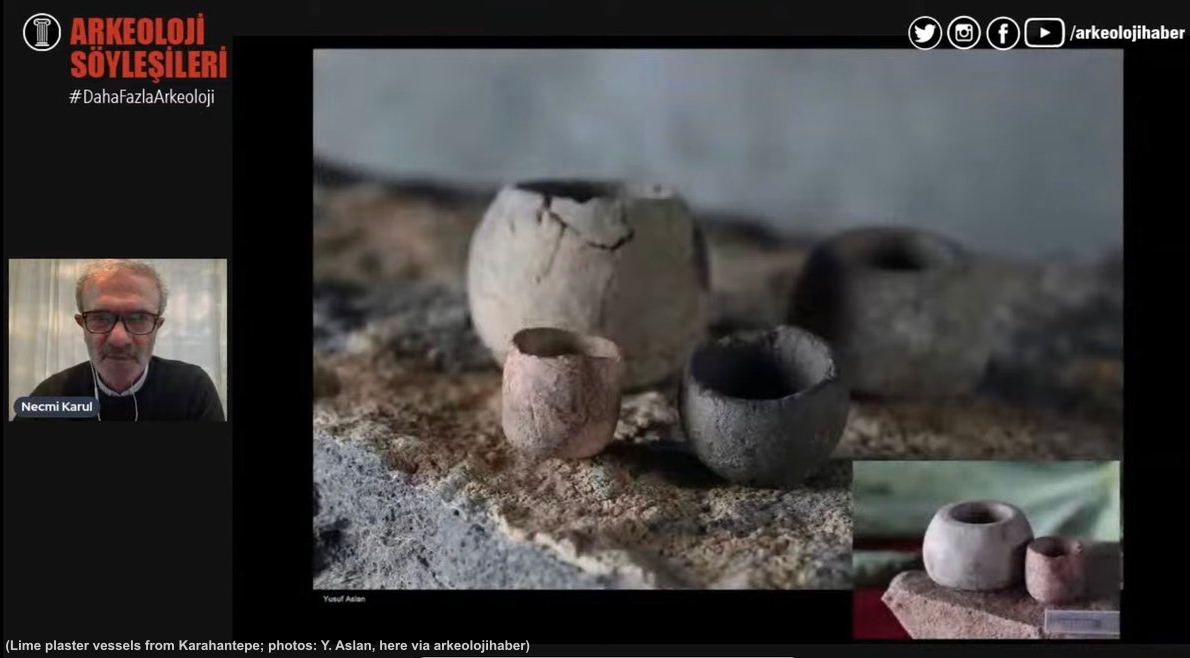
Maybe fuelled by recent claims that #Neolithic hunters were too "simple" and thus not capable of cultural achievements, there seems to be a misunderstanding about the "#pottery" part in #PrePotteryNeolithic (PPN).
They actually *did* use vessels. Just other vessels.
A short 🧵:
They actually *did* use vessels. Just other vessels.
A short 🧵:

Well known and clearly associated with #PrePotteryNeolithic contexts are e.g. #StoneVessels from different places like #KörtikTepe in Turkey or #JerfElAhmar and #TellAbr in Syria as well as (often fragmented though) many more related sites (including Göbekli Tepe by the way). 

Bringing up the #GöbekliTepe fragments since they illustrate why finding complete vessels is comparably rare: the material was too valuable to not re-use it.
@lauradietrich_, @odietrich_, & myself discussed the "afterlife" of such #StoneVessels here:
jensnotroff.files.wordpress.com/2020/10/ii.20_…
@lauradietrich_, @odietrich_, & myself discussed the "afterlife" of such #StoneVessels here:
jensnotroff.files.wordpress.com/2020/10/ii.20_…

We also have to consider a variety of other vessels made from material simply not preserved, e.g. leather containers or wood and bark #vessels - like the exceptional examples found with Late Neolithic/Chalcolihtic #Ötzi or the Bronze Age #Egtved Girl's burial in Denmark: 



The point is: They could - and *did* make vessels.
Just not pottery vessels. Probably because of the fragility of this material - which may not be the most practical thing for highly mobile people repeatedly packing up all their stuff and moving on to the next place.
Just not pottery vessels. Probably because of the fragility of this material - which may not be the most practical thing for highly mobile people repeatedly packing up all their stuff and moving on to the next place.
#PrePotteryNeolithic hunters likely were aware of these properties - they did experiment w/ related materials, as numerous figurines (e.g. from #NevaliCori), sculptures (e.g. from #AinGhazal), even a few small vessels made of gypsum plaster (e.g. from #Karahantepe) demonstrate. 





Even more: Already in their seminal works on #Neolithic #lime and #gypsum plasters, Kingery et al. (quite fittingly) described this technology as "The Beginnings of #Pyrotechnology" (J. Field Arch. 2(1/2), 1975 + J. Field Arch. 15, 1988):
repository.si.edu/bitstream/hand…
repository.si.edu/bitstream/hand…
The term #PrePotteryNeolithic was coined by K. Kenyon at the type site of #Jericho (Tell es-Sultan) to distinguish #Neolithic layers lacking any pottery from those w/ such implements.
It thus is a technical classification applying to this specific region - not a cultural stage.
It thus is a technical classification applying to this specific region - not a cultural stage.
In fact do we indeed know of earlier examples for #pottery. Pottery #vessels - e.g. from Siberia, Japan, Korea, and China - dating as far back as 18,000 years.
Interestingly often associated with hunter-fisher cultures (with a lower degree of mobility).
science.org/content/articl…
Interestingly often associated with hunter-fisher cultures (with a lower degree of mobility).
science.org/content/articl…

Further referenced sources:
researchgate.net/publication/32…
iceman.it/de/ausruestung
en.natmus.dk/historical-kno…
researchgate.net/publication/32…
web.archive.org/web/2008051105…
pnas.org/doi/full/10.10…
researchgate.net/publication/22…
scholarspace.manoa.hawaii.edu/server/api/cor…
researchgate.net/publication/32…
iceman.it/de/ausruestung
en.natmus.dk/historical-kno…
researchgate.net/publication/32…
web.archive.org/web/2008051105…
pnas.org/doi/full/10.10…
researchgate.net/publication/22…
scholarspace.manoa.hawaii.edu/server/api/cor…
Thanks for your great feedback! Happily taking up some of the suggestions:
#Gourds e.g. has been pointed out as another organic vessel resource - not leaving much of a trace in the archaeological record. W/ view to ethnographic analogies this indeed has to be considered as well.

#Gourds e.g. has been pointed out as another organic vessel resource - not leaving much of a trace in the archaeological record. W/ view to ethnographic analogies this indeed has to be considered as well.


As well as #basketry. In fact, some ornaments on early pottery vessels do indeed seem to somehow reproduce the appearance of woven surfaces.
Here some breathtakingly well preserved examples from #Neolithic #Spain (with thanks to @AlisonFisk):
Here some breathtakingly well preserved examples from #Neolithic #Spain (with thanks to @AlisonFisk):
https://twitter.com/AlisonFisk/status/1536775778423250944?s=20&t=ApmqF_rROVEVOqN-B7LBJg
And not to forget #OstrichEggs! Many known finds of vessels made out of such eggs, with a wide geographic and chronological variety - including e.g. Neolithic Jordan, Sudan, predynastic Egypt and many more. Well into recent history. 

The path to #pottery (vessel) production really is a fascinating cultural development.
A recent volume on "The Emergence of Pottery in West Asia" (eds. A. Tsuneki, O. Nieuwenhuyse, & St. Campbell, Oxbow 2017) gives an overview on the current discussion:
oxbowbooks.com/oxbow/the-emer…
A recent volume on "The Emergence of Pottery in West Asia" (eds. A. Tsuneki, O. Nieuwenhuyse, & St. Campbell, Oxbow 2017) gives an overview on the current discussion:
oxbowbooks.com/oxbow/the-emer…

Olivier Nieuwenhuyse's and Stuart Campbell's synthesis on "The Emergence of #Pottery in #WestAsia" in the same volume e.g. makes a great introductory evening reading:
academia.edu/36640138/Synth…
academia.edu/36640138/Synth…
• • •
Missing some Tweet in this thread? You can try to
force a refresh















